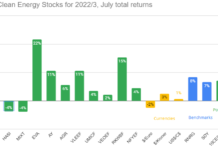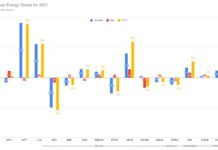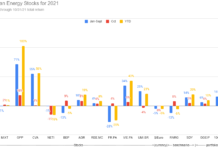![]() I’m trying something different and doing quick updates on individual stocks in my 10 Clean Energy Stocks model portfolio as I have time to write. The portfolio as a whole has been accelerating with the instant torque of an electric vehicle this year (details here.) I thought I’d start with the company that’s newest to my readers,
I’m trying something different and doing quick updates on individual stocks in my 10 Clean Energy Stocks model portfolio as I have time to write. The portfolio as a whole has been accelerating with the instant torque of an electric vehicle this year (details here.) I thought I’d start with the company that’s newest to my readers,
Valeo SA (FR.PA, VLEEF)
12/31/18 Price: €25.21/$28.20. Annual Dividend: €1.25. Expected 2019 dividend: €1.25. 03/4/19 price: €29.13/$33.00. YTD gain: 15.5% Euro/ 12.8% USD.
I added this stock to the portfolio because it has great technology and and improving market share, but weak industry growth and overoptimistic management projections in 2018 led the stock to get massively beaten down. Despite the horrible year, the company was still profitable and paid a healthy dividend, with a respectable 5% yield compared to its beaten down stock price.
This meets the profile of one of my favorite types of stocks: a profitable growth company that got a bit ahead of itself when times were good, and with a stock that suffered deeply as a consequence when growth investors abandoned the stock.
Some of my past picks of this type are Mix Telematics (MIXT), and General Cable (BGC). Mix was a bet that took 3 years to pay off (It was in the list in 2015, 2016, and 2017, but it is now trading well above where I first entered the stock and readers who added to their positions in 2016 and early 2017 are looking at 400% gains. Readers who bought General Cable when I added it to the list in 2015 also had to wait almost two years, but saw it double when the company was bought out at the end of 2017. Although the payoffs took 2-3 years in both cases, investors were being paid to wait with 4-8% dividends in the meantime.
More recently Seaspan Worldwide Preferred shares (SSW-PG in 2017) and common shares (SSW in 2018) both paid off (33% and 24% respectively) over the same years in which I picked them. In this year’s list, Green Plains Partners (GPP) and Covanta Holding (CVA) also fit that profile. These first entered the portfolio in 2016 and 2017, respectively. The stock prices are down 1% over three years and up 7% over two, but they have both been reliable dividend payers the whole time.
Valeo feels like a similarly safe bet. It could recover this year, or take a few years, before investors get interested in it again. Meanwhile, we’re being paid 5% on our purchase price to wait as long as it takes.
Valeo announced annual 2018 results on February 21st. They hit their much-revised guidance (an easy task since they had most recently revised it in October, when most of the year’s revenue had already been booked. The company is projecting modest growth in 2019 based on revenue from new products. At least some of this growth seems very likely to materialize because the company says that it is based on “the start of production on new contracts, particularly in the camera, electrical and transmission systems, and lighting segments.” Note that this is not the signing of new contracts, but contracts which have already been finalized and only have to start production.
If the auto market weakens further, some of this new production may be pushed back, but at the price we bought the stock, we can afford to wait. If the predicted growth materializes, we will see the stock price appreciate, leading to possible significant gains.
Also worth noting is that the company maintained its €1.25 dividend. While this is not the dividend growth the company has had in the past, it means we are being paid to wait for the eventual dividend increase, which I expect in the next 3 years.
A note about US OTC tickers for foreign stocks
A long time reader asked what was the right US ticker (VLEEF or VLEEY) for Valeo. The answer can be complicated for foreign stocks, so I will reprint my entire response here:
I prefer VLEEF. When you buy a pink sheet stock that ends in an “F” you are buying the actual foreign share in the over the counter market. Typically a middleman will buy the stock on the foreign exchange for you and charge a small mark-up for the service. Always buy with limit orders, or it could be a large mark-up. When you buy a foreign stock that ends in a “Y” you are buying an ADR (American Depository Receipt.) This is a US security backed by shares of the foreign company which are held in trust at a bank or similar institution. The institution charges an annual fee (usually deducted from your dividends) for this service. ADRs often have greater liquidity, but I don’t think pink sheet ADRs are worth it if you can buy the actual stock. Sometimes listed ADRs, which trade on real exchanges, are worth it. For example, MIXT is an ADR, and I use it because I have not found any other way to buy Mix Telematics in the US. But OTC, I always buy “BLAHF” rather than “BLAHY”.
Disclosure: Long VLEEF, MIXT, SSW-PG, SSW.







